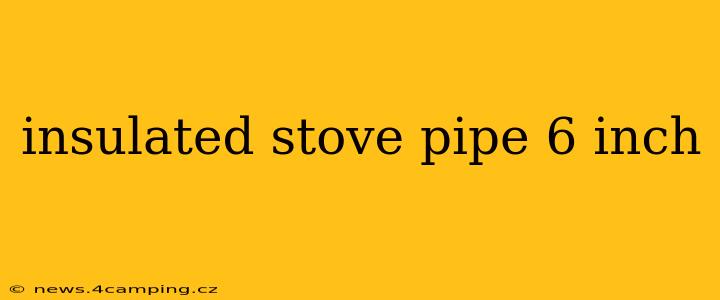Choosing the right stove pipe is crucial for safe and efficient wood burning. This guide focuses specifically on 6-inch insulated stove pipe, covering everything from its benefits to installation considerations. Understanding the specifics of insulated pipe, particularly its diameter, is key to preventing chimney fires and ensuring optimal performance of your wood-burning appliance.
What are the Benefits of Insulated Stove Pipe?
Insulated stove pipe offers several key advantages over single-wall pipe. The most significant benefit is reduced surface temperature. The insulation layer significantly lowers the external temperature of the pipe, minimizing the risk of igniting combustible materials near the stovepipe. This added safety is crucial, especially in older homes or areas with flammable materials close to the chimney.
Another advantage is improved efficiency. By reducing heat loss through the pipe, insulated stove pipe helps maintain a higher flue gas temperature. This can lead to more complete combustion and potentially slightly improved heating efficiency. Though the impact on overall efficiency might be marginal, every bit helps in optimizing your wood-burning system.
Finally, insulated stove pipes often have a longer lifespan. The insulation layer protects the inner pipe from the intense heat, reducing the rate of deterioration and extending the pipe’s useful life.
What Size Insulated Stove Pipe Do I Need?
Determining the correct size of your stove pipe is paramount for safety and efficiency. A 6-inch diameter pipe is a common size, but its suitability depends on your specific stove and chimney system. Always consult your stove's installation manual for the recommended pipe size and specifications. Using an incorrectly sized pipe can lead to dangerous situations.
The manual will specify the correct diameter to ensure proper draft and efficient combustion. Using a pipe that's too small can restrict airflow, causing creosote buildup and increasing the risk of a chimney fire. Conversely, a pipe that's too large can negatively impact the draft, reducing efficiency and possibly leading to smoke backdrafting into your home.
How Much Clearance is Needed for 6-Inch Insulated Stove Pipe?
Maintaining proper clearances around your stovepipe is vital for fire safety. The required clearance will vary based on the specific type of insulation used and local building codes. Consult your stove's installation manual and local building codes for the exact clearance requirements. These requirements usually dictate the minimum distance between the pipe and any combustible materials like wood framing, drywall, or insulation.
What are the Different Types of Insulation Used in Stove Pipe?
Several types of insulation are used in insulated stove pipe. Common options include fiberglass, ceramic fiber, and mineral wool. Each type offers different levels of insulation and heat resistance. The choice of insulation material will affect the overall performance and cost of the pipe. Again, refer to your stove's installation manual for recommended insulation types.
Is 6-Inch Insulated Stove Pipe Suitable for All Stoves?
No, 6-inch insulated stove pipe is not universally suitable for all wood-burning stoves. The appropriate pipe size is dictated by the stove's specifications, and it's crucial to match the pipe size precisely to the stove's outlet. Using an incompatible size can lead to inefficient combustion, poor draft, and significant safety hazards. Always prioritize safety and follow the manufacturer's guidelines.
How Do I Install 6-Inch Insulated Stove Pipe Safely?
Correct installation of stove pipe is critical for safe operation. This typically involves using specialized connectors and ensuring proper sealing at each joint to prevent leaks and creosote buildup. Consult your stove's installation manual for detailed instructions and safety precautions. Improper installation can lead to dangerous situations, including chimney fires and carbon monoxide poisoning. Consider seeking professional help if you lack the necessary experience or skills.
This comprehensive guide provides crucial information regarding 6-inch insulated stove pipes. Remember, safety is paramount, and always consult your stove's installation manual and relevant building codes for specific instructions and recommendations. Using the correct size and installing the pipe correctly will ensure the safe and efficient operation of your wood-burning appliance.
